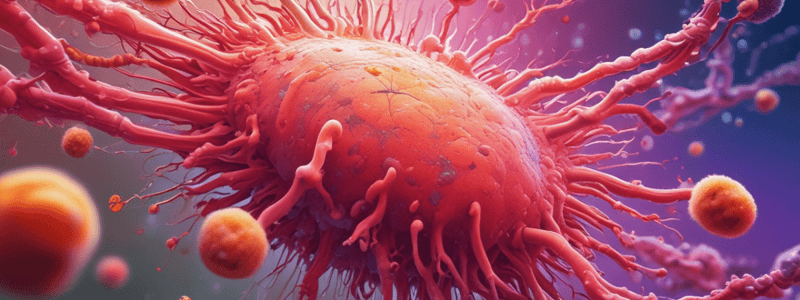Podcast
Questions and Answers
What is the most distinctive feature of Group B Streptococcus (Streptococcus agalactiae)?
What is the most distinctive feature of Group B Streptococcus (Streptococcus agalactiae)?
- It causes meningitis in newborns
- It has a polysaccharide capsule
- It is beta-hemolytic
- It is gram positive and catalase negative (correct)
Which test is used to specifically identify Group B Streptococcus?
Which test is used to specifically identify Group B Streptococcus?
- Bacitracin resistance test
- Hippurate hydrolysis test (correct)
- CAMP test
- Gram stain
What is the major virulence factor of Group B Streptococcus?
What is the major virulence factor of Group B Streptococcus?
- Ability to cause beta-hemolysis
- Polysaccharide capsule (correct)
- Resistance to bacitracin
- Polypeptide that complements sphingomyelinase
Which of the following is the primary mode of transmission for Group B Streptococcus?
Which of the following is the primary mode of transmission for Group B Streptococcus?
What is the recommended prevention strategy for Group B Streptococcus infection in newborns?
What is the recommended prevention strategy for Group B Streptococcus infection in newborns?
Which antibiotic regimen is typically used to treat Group B Streptococcus infections in newborns?
Which antibiotic regimen is typically used to treat Group B Streptococcus infections in newborns?
What is the significance of the purple color in the image?
What is the significance of the purple color in the image?
What does the 'Hippo doll' in the image represent?
What does the 'Hippo doll' in the image represent?
What does the 'Camp tent' in the image signify?
What does the 'Camp tent' in the image signify?
Which of the following is the primary mode of transmission for Group B Streptococcus?
Which of the following is the primary mode of transmission for Group B Streptococcus?
Which of the following clinical manifestations is Group B Streptococcus most likely to cause in newborns?
Which of the following clinical manifestations is Group B Streptococcus most likely to cause in newborns?
What is the recommended prevention strategy for Group B Streptococcus infection in newborns?
What is the recommended prevention strategy for Group B Streptococcus infection in newborns?
Flashcards are hidden until you start studying
Study Notes
Group B Strep (Strep agalactiae)
- Gram positive, catalase negative
- Causes major infections in newborns
Features
- Positive hippurate test, hydrolyzes Na+ hippurate
- Polysaccharide capsule is a virulence factor
- cAMP test positive, has an increasing zone of hemolysis
- Beta-hemolytic
- Bacitracin resistant
Diseases
- Most likely to cause meningitis in neonates
- Most likely to cause sepsis in neonates
- Causes pneumonia
Transmission
- Transmission of group B strep through vaginal canal
- Transmission through GI Tract
Prevention
- Mothers are cultured for Group B strep at 35 weeks
- Penicillin is given to mom intrapartum to prevent Group B Strep
Treatment
- Give baby ampicillin with an aminoglycoside or cephalosporin
Studying That Suits You
Use AI to generate personalized quizzes and flashcards to suit your learning preferences.




